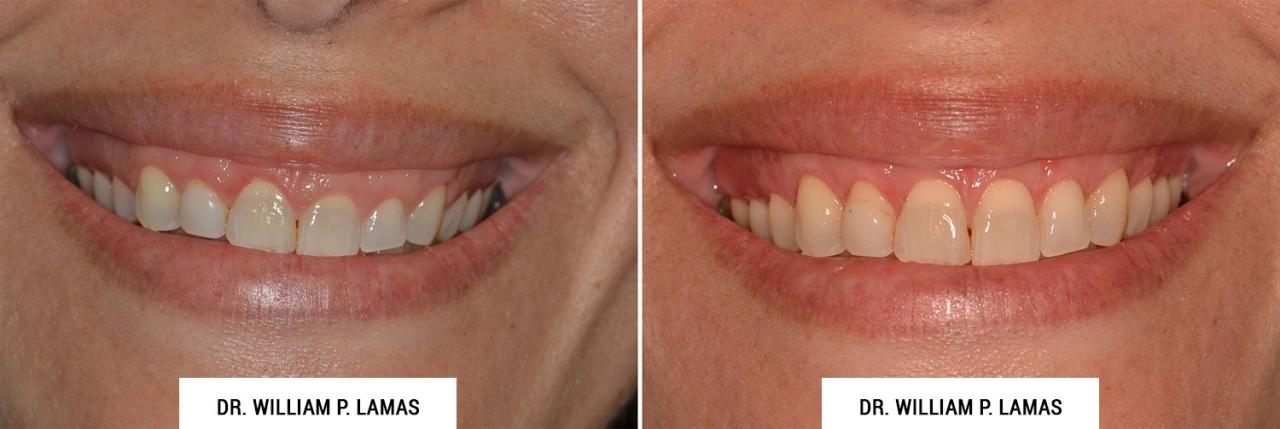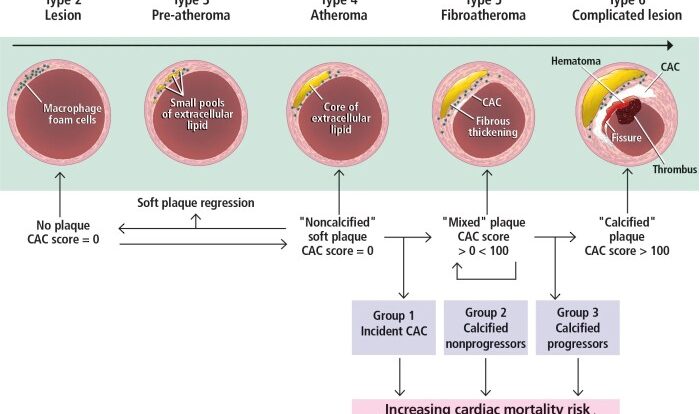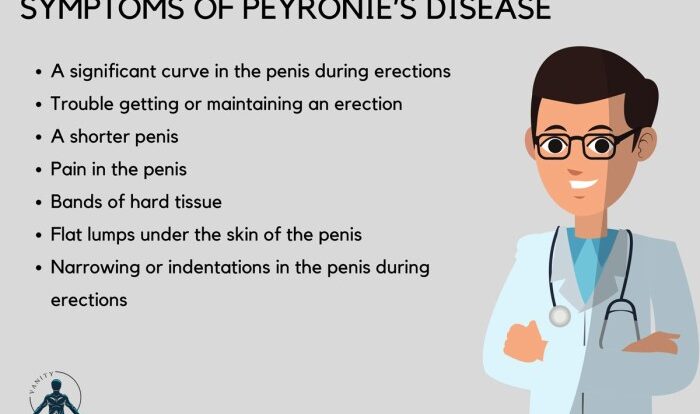Crown lengthening before and after takes center stage, beckoning readers into a world crafted with good knowledge. Get ready for an absorbing and distinctly original reading experience as we delve into the concise and clear realm of crown lengthening.
In this article, we will explore what crown lengthening is, its purpose, and the conditions that may require it. We will also uncover the benefits of crown lengthening, including how it can improve oral health and enhance the appearance of teeth.
Additionally, we’ll walk you through the crown lengthening procedure, discuss pre-operative preparations, and provide post-operative care instructions. Finally, we’ll touch upon the success rate of crown lengthening and alternatives for those who may not be suitable candidates. So, let’s embark on this informative journey together!
Introduction to Crown Lengthening
Crown lengthening is a dental procedure that involves the removal of gum tissue or bone to expose more of the tooth’s surface. It is typically performed to enhance the appearance of a smile or to prepare a tooth for restorative treatment.
The procedure can be done on a single tooth or multiple teeth, depending on the patient’s needs.During crown lengthening, the dentist will use local anesthesia to numb the area and then make small incisions in the gums to access the underlying bone.
They will carefully remove excess gum tissue or bone to expose more of the tooth’s crown, which is the visible part of the tooth above the gum line. After the procedure, the gums are stitched back together, and a temporary protective dressing may be placed over the treated area.Crown
lengthening may be necessary in a variety of situations. It is commonly done when a tooth is broken or decayed below the gum line, making it difficult to place a dental crown or filling. In these cases, crown lengthening allows the dentist to access and restore the tooth properly.
Additionally, crown lengthening can be done for aesthetic purposes, such as when a patient has a “gummy smile” and wants to expose more of their teeth for a more balanced appearance.
Conditions that may require crown lengthening
Crown lengthening may be recommended in the following situations:
- To expose more of a tooth’s surface for restorative treatment
- To repair a tooth that is broken or decayed below the gum line
- To create space for a dental crown or filling
- To improve the appearance of a “gummy smile”
- To address uneven gum line or excessive gum tissue
It is important to note that crown lengthening is a surgical procedure that should be performed by a qualified dentist or periodontist. They will carefully evaluate the patient’s oral health and determine if crown lengthening is the appropriate treatment option for their specific case.
Benefits of Crown Lengthening

Crown lengthening is a dental procedure that offers several advantages for patients. It can improve oral health and enhance the appearance of teeth.Crown lengthening is often performed to expose more of the tooth structure, which can provide several benefits:
Improved Oral Health
- Reduces the risk of tooth decay: By exposing more of the tooth, crown lengthening allows for better access to clean the area and remove plaque and bacteria.
- Treats gum disease: Crown lengthening can address gum disease by reducing the depth of the gum pockets and making it easier to clean the area.
- Preserves tooth structure: In cases where a tooth is fractured or decayed below the gum line, crown lengthening can expose more of the tooth, allowing for restorative procedures such as fillings or crowns.
Enhanced Appearance of Teeth
Crown lengthening can also improve the aesthetic appearance of teeth by:
- Creating a more balanced smile: Crown lengthening can correct a “gummy smile” by removing excess gum tissue and revealing more of the tooth structure.
- Improving the proportions of teeth: Crown lengthening can enhance the symmetry and proportions of the teeth, creating a more pleasing smile.
- Facilitating restorative procedures: Crown lengthening can make it possible to place dental crowns or veneers, improving the shape and alignment of the teeth.
Crown lengthening offers both functional and cosmetic benefits, making it a valuable treatment option for patients seeking to improve their oral health and enhance the appearance of their teeth.
Crown Lengthening Procedure

Crown lengthening is a dental procedure that involves the removal of gum tissue and, in some cases, small amounts of bone to expose more of the tooth’s surface. This procedure is commonly performed to prepare a tooth for a dental crown or to improve the appearance of a gummy smile.The
steps involved in the crown lengthening procedure are as follows:
1. Evaluation
Before the procedure, the dentist will evaluate the tooth and surrounding tissues to determine the extent of crown lengthening required. X-rays may be taken to assess the bone level and the proximity of the tooth to the adjacent teeth.
2. Administration of Local Anesthesia
Local anesthesia is used to numb the area being treated. This ensures that the patient does not experience any pain or discomfort during the procedure.
3. Incision
Once the area is numb, the dentist will make small incisions in the gum tissue around the tooth. This allows access to the underlying bone and helps in repositioning the gumline.
4. Bone Reshaping (if necessary)
In some cases, it may be necessary to remove small amounts of bone to achieve the desired results. This is done using dental instruments and is performed with precision to ensure the stability and health of the tooth.
5. Gum Repositioning
After reshaping the bone, the dentist will reposition the gum tissue to expose more of the tooth’s surface. The gum tissue is carefully sutured back into place using dissolvable stitches.
6. Healing and Follow-up
After the procedure, the patient will be given post-operative instructions to follow. It is important to maintain good oral hygiene and avoid any activities that may disrupt the healing process. Follow-up appointments will be scheduled to monitor the healing and ensure the success of the procedure.
Techniques Used for Crown Lengthening
There are two main techniques used for crown lengthening:
1. Gingivectomy
This technique involves the removal of excess gum tissue to expose more of the tooth’s surface. It is typically used in cases where there is an overgrowth of gum tissue, resulting in a gummy smile or difficulty in placing a dental crown.
2. Osseous Surgery
This technique involves the removal of both gum tissue and small amounts of bone to expose more of the tooth’s surface. It is used when there is excess gum tissue as well as an excessive bone that needs to be reshaped.Both
techniques aim to create a balance between the tooth structure, gum tissue, and bone to achieve an aesthetically pleasing and functional result.
Use of Local Anesthesia during the Procedure
Local anesthesia is an essential part of the crown lengthening procedure. It is administered to numb the area being treated, ensuring that the patient does not experience any pain or discomfort. The use of local anesthesia allows the dentist to perform the necessary incisions, bone reshaping, and gum repositioning without causing any pain.The
type of local anesthesia used may vary depending on the patient’s preference and the dentist’s recommendation. Commonly used local anesthetics include lidocaine and articaine. These anesthetics are injected into the gum tissue near the tooth being treated, numbing the area for the duration of the procedure.It
is important to note that while local anesthesia numbs the area and prevents pain during the procedure, some patients may experience mild discomfort or pressure. The dentist will ensure the patient’s comfort by adjusting the anesthesia as needed.Overall, the use of local anesthesia during crown lengthening procedures ensures a comfortable experience for the patient while allowing the dentist to perform the necessary steps to achieve the desired results.
Before the Crown Lengthening Procedure
Before undergoing the crown lengthening procedure, there are certain preparations that need to be made to ensure a successful outcome. These preparations include diagnostic tests and evaluations, as well as instructions for medication and oral hygiene.
Diagnostic Tests and Evaluations
Prior to the crown lengthening procedure, your dentist or periodontist may perform several diagnostic tests and evaluations. These tests help determine the extent of the crown lengthening needed and ensure that it is the appropriate treatment for your specific case.
Some of the diagnostic tests and evaluations that may be conducted include:
- Dental X-rays: X-rays are taken to assess the overall health of your teeth and jawbone. They provide valuable information about the bone structure and help determine the amount of bone that needs to be exposed during the procedure.
- Gum examination: Your dentist will examine your gums to evaluate their health and determine if there are any signs of gum disease or infection. This helps ensure that the crown lengthening procedure can be performed safely.
- Measurement of gum and bone levels: Measurements are taken to determine the current position of the gumline and the amount of bone that needs to be exposed. This information is used to plan the crown lengthening procedure and achieve the desired results.
Medication and Oral Hygiene Instructions
Before the crown lengthening procedure, your dentist or periodontist will provide you with instructions regarding medication and oral hygiene. It is important to follow these instructions to minimize the risk of complications and ensure optimal healing. Some of the instructions you may receive include:
- Medication: You may be prescribed antibiotics to prevent infection and pain medication to manage any discomfort after the procedure. It is important to take the prescribed medications as directed.
- Oral hygiene: Maintaining good oral hygiene is crucial before the crown lengthening procedure. Your dentist may recommend using an antimicrobial mouthwash or a special toothbrush to clean the area around the gums and teeth. It is important to brush and floss regularly to keep your teeth and gums healthy.
- Smoking cessation: If you are a smoker, it is highly recommended to quit smoking before the crown lengthening procedure. Smoking can impair the healing process and increase the risk of complications.
By following these pre-operative preparations, including diagnostic tests and evaluations, and following the instructions for medication and oral hygiene, you can help ensure a successful crown lengthening procedure and achieve the desired results.
After the Crown Lengthening Procedure
After undergoing crown lengthening, it is important for patients to follow proper post-operative care to ensure proper healing and minimize complications. Here are some guidelines to follow:
Post-Operative Care
- Take prescribed pain medications as directed by your dentist or oral surgeon to manage any discomfort or pain.
- Apply ice packs or cold compresses on the affected area to reduce swelling. Use them for about 15 minutes at a time, with breaks in between.
- Follow a soft food diet for the first few days after the procedure to avoid putting excessive pressure on the surgical site. Opt for foods that are easy to chew and swallow, such as yogurt, mashed potatoes, and soup.
- Avoid smoking and drinking alcohol during the recovery period, as these habits can hinder the healing process and increase the risk of complications.
- Practice good oral hygiene by gently brushing your teeth and using a mild mouthwash. Be careful around the surgical site to avoid causing any irritation.
- Avoid strenuous physical activities and exercise for at least a few days after the procedure to prevent any excessive bleeding or discomfort.
- Attend follow-up appointments with your dentist or oral surgeon to monitor the healing progress and address any concerns or complications that may arise.
Recovery Process and Timeline
The recovery process after crown lengthening varies from patient to patient. Generally, it takes about 1 to 2 weeks for the initial healing of the gums. However, complete healing and the final results may take several months.
During the first few days after the procedure, you may experience some swelling, discomfort, and mild bleeding. These symptoms should gradually improve over time.
It is important to note that every individual’s healing process is unique. Factors such as overall health, oral hygiene, and adherence to post-operative care instructions can influence the recovery timeline.
Potential Complications or Risks
While crown lengthening is generally a safe procedure, there are potential complications and risks that patients should be aware of:
- Infection: Poor oral hygiene or inadequate post-operative care can increase the risk of infection at the surgical site. It is important to follow proper oral hygiene practices and attend follow-up appointments to monitor the healing progress.
- Swelling and Discomfort: Swelling and discomfort are common after the procedure but should subside over time. However, if the swelling worsens or is accompanied by severe pain or other concerning symptoms, it is important to consult your dentist or oral surgeon.
- Tooth Sensitivity: Some patients may experience temporary tooth sensitivity after crown lengthening. This typically resolves on its own but can be managed with desensitizing toothpaste or other dental products.
- Uneven Gumline: In rare cases, crown lengthening may result in an uneven gumline. Your dentist or oral surgeon will take precautions to ensure a balanced and aesthetically pleasing outcome, but sometimes additional procedures may be necessary to achieve the desired result.
Alternatives to Crown Lengthening
Crown lengthening may not be suitable for every patient. In such cases, there are alternative treatment options available that can address the same issues. These alternatives have their own benefits and drawbacks, and it is important to determine the most appropriate treatment plan for each patient based on their individual needs and circumstances.
1. Veneers or Bonding, Crown lengthening before and after
Veneers or bonding can be a viable alternative to crown lengthening for patients with minor cosmetic concerns. These procedures involve applying thin shells of porcelain or composite resin to the front surface of the teeth, effectively altering their appearance. Veneers and bonding can help improve the shape, size, and color of teeth, giving them a more pleasing aesthetic.
- Veneers: Made from porcelain, veneers are custom-made to fit over the front surface of the teeth. They can address issues like small teeth, gaps, discoloration, and minor misalignment.
- Bonding: In bonding, a tooth-colored resin material is applied to the teeth and shaped to achieve the desired appearance. This can help correct small chips, gaps, and discoloration.
2. Orthodontic Treatment
Orthodontic treatment, such as braces or clear aligners, can be an alternative for patients with crowding, spacing, or misalignment issues. By gradually moving the teeth into proper alignment, orthodontic treatment can improve both the appearance and functionality of the teeth.
- Braces: Traditional braces consist of metal brackets and wires that apply gentle pressure to gradually shift the teeth. They are highly effective in correcting various orthodontic issues.
- Clear aligners: These are a more discreet alternative to braces. Clear aligners are removable trays made from transparent plastic that gradually move the teeth. They are a popular choice for patients who prefer a more aesthetic option.
3. Gum Contouring
Gum contouring, also known as gum reshaping, is a procedure that involves removing excess gum tissue to reveal more of the tooth structure. It can be an alternative to crown lengthening for patients with a gummy smile or uneven gum line.
Gum contouring can help create a more balanced and aesthetically pleasing smile.
- Laser gum contouring: This technique uses a dental laser to precisely remove excess gum tissue. It is a minimally invasive and relatively comfortable procedure with minimal downtime.
- Surgical gum contouring: In some cases, a surgical approach may be necessary to reshape the gum line. This involves making incisions and removing or reshaping the excess gum tissue. It may require a longer recovery period.
4. Full Coverage Restorations
For patients with extensive tooth damage or structural issues, full coverage restorations can be an alternative to crown lengthening. These restorations, such as dental crowns or bridges, completely cover the affected teeth, providing both functional and aesthetic benefits.
- Dental crowns: Crowns are custom-made caps that are placed over the entire tooth to restore its shape, size, strength, and appearance. They can be made from various materials, including porcelain, metal, or a combination of both.
- Dental bridges: Bridges are used to replace one or more missing teeth. They consist of artificial teeth that are anchored to the adjacent natural teeth or dental implants. Bridges can restore the appearance and functionality of the smile.
Determining the most appropriate treatment plan for each patient requires a thorough evaluation of their dental condition, cosmetic goals, and overall oral health. It is essential to consult with a qualified dental professional to discuss the available alternatives to crown lengthening and decide on the best course of action.
Last Word
In conclusion, crown lengthening before and after offers a clear path to enhanced oral health and a brighter smile. By understanding the procedure, its benefits, and the necessary care, you can make an informed decision about your dental treatment. Remember to consult with a qualified professional to determine the most appropriate treatment plan for your specific needs.
With crown lengthening, you can achieve a confident and healthy smile that lasts a lifetime.
Essential Questionnaire: Crown Lengthening Before And After
What is crown lengthening and why is it done?
Crown lengthening is a dental procedure aimed at exposing more of the tooth structure by removing excess gum tissue. It is done to improve the health of the gums, enhance the appearance of teeth, and facilitate other dental treatments such as crown placement.
Does crown lengthening hurt?
During the procedure, local anesthesia is used to numb the area, so you shouldn’t feel pain. However, you may experience some discomfort or soreness after the anesthesia wears off. Your dentist will provide you with appropriate pain management instructions to ensure a comfortable recovery.
How long does it take to recover from crown lengthening?
The recovery time can vary depending on the individual and the extent of the procedure. Generally, it takes about 1-2 weeks for the gums to heal completely. However, it’s important to follow your dentist’s instructions for post-operative care to promote proper healing and minimize any complications.
What are the potential risks of crown lengthening?
Like any surgical procedure, crown lengthening carries some risks. These can include infection, bleeding, swelling, and sensitivity. However, with proper pre-operative preparation and post-operative care, the risks can be minimized. Your dentist will discuss these risks with you and address any concerns you may have.
Are there alternatives to crown lengthening?
Yes, there are alternative treatment options for individuals who may not be suitable candidates for crown lengthening. These can include orthodontic treatments, veneers, or dental bonding. It’s important to consult with your dentist to determine the most appropriate treatment plan based on your specific dental needs and goals.





